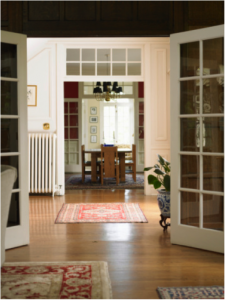 When decorating, it’s not enough to design each room separately; you also need to think about what happens as you look through doorways and move from one room to another.
When decorating, it’s not enough to design each room separately; you also need to think about what happens as you look through doorways and move from one room to another.
As you plan your décor, think about the transitions. In a way, walking through a home is like reading a book. You don’t want too much of a disconnection from one chapter to the next, but if they’re all the same it becomes boring. Your home can find this balance from room to room.
These photos show the same home from two directions. It has particular challenges because the positions of these doorways allow the eye to view four rooms from one position. This requires even more transitional planning. In the first photo, the entryway looks into the living room and then a sunroom.
The second photo shows the house from the other direction, standing in the living room and looking through the entryway to the dining room and one side of the kitchen. Each room has its own feel, and instead of making the home feel disjointed, it adds interest. Let’s look at why. First, the living, dining and entryway share rich wood flooring. This is the most consistent feature across the rooms, and compensates for the differences in wall color and details. The sunroom has different flooring, but having the step-down into the room allows that space to vary from the rest. The other design consistency comes from the doors themselves. The glass French doors help keep the space feeling open while echoing the same style from room to room.
the rooms, and compensates for the differences in wall color and details. The sunroom has different flooring, but having the step-down into the room allows that space to vary from the rest. The other design consistency comes from the doors themselves. The glass French doors help keep the space feeling open while echoing the same style from room to room.
Finally, the choice to scatter smaller Oriental rugs maintains a design link in spite of the different colors and furniture styles. With one room in a vivid red, one with wood paneling and the other two painted white and cream, color links from room to room come from the furniture and art. This allows each room to feature one color or tone while making sure that all of the rooms feel cohesive. Find your connective elements and then have fun letting each room feature its own design look and style.
